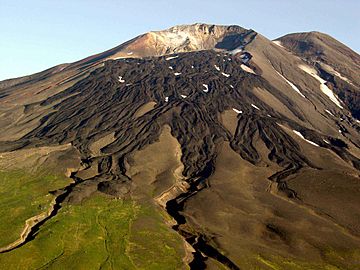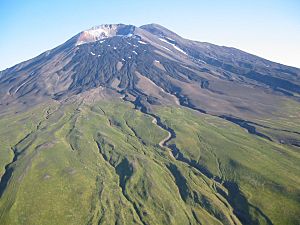Mount Gareloi facts for kids
Quick facts for kids Mount Gareloi |
|
|---|---|

Summit of the volcano
|
|
| Highest point | |
| Elevation | 5,161 ft (1,573 m) |
| Prominence | 5,161 ft (1,573 m) |
| Listing |
|
| Geography | |
| Location | Gareloi Island, Alaska, U.S. |
| Parent range | Aleutian Islands |
| Geology | |
| Age of rock | Holocene-Pleistocene |
| Mountain type | Stratovolcano |
| Volcanic arc/belt | Aleutian Arc |
| Last eruption | August 1989 |
Mount Gareloi, also known as Gareloi Volcano, is a large, cone-shaped stratovolcano. It is located in the Aleutian Islands of Alaska, United States. This volcano is about 1259 miles (2026 km) away from Anchorage.
Mount Gareloi is on Gareloi Island, making up most of the island's land. The island also has two small glaciers. These glaciers stick out towards the northwest and southeast. The volcano is about 6 miles (10 km) by 5 miles (8 km) at its base. It has two main peaks or summits.
The southern peak has a much larger crater, about 984 feet (300 meters) wide. This crater has fumaroles, which are vents that release steam and gases. The northern peak's crater is completely enclosed.
Contents
Exploring Mount Gareloi: Discovery and Access
Vitus Bering was a famous sailor from Russia. After several successful trips in the 1720s and 1730s, he was sent to explore the Pacific Ocean in 1740. This area is now known as the Bering Sea. Bering set up a base in Kamchatka and built two ships, the St. Peter and St. Paul.
In 1741, Bering and his crew sailed towards North America. A big storm forced them to stop and land. During the storm, they couldn't see the Alaskan coast clearly. The storm was too strong, so the ships turned back. On their way, they mapped several of the Aleutian Islands, including Gareloi. Since then, Mount Gareloi has not been studied much. Because of this, we don't know everything about its past eruptions.
Gareloi Island has no people living on it. It is part of the Alaska Maritime National Wildlife Refuge. This refuge is looked after by the U.S. Fish and Wildlife Service.
Understanding Gareloi's Geography and Geology
Gareloi is the most northern volcano in the Delarof Group. This group is a part of the Aleutian Islands. The volcano has two craters. The older crater is covered by lava flows that reach the northwest and southern coasts.
The northern crater is small. It has a feature that suggests a dome collapse on its northwest side. The southern crater is higher up and much bigger. It shows signs of fumarolic activity, meaning gases are escaping. A fissure, or crack, was made during Gareloi's 1929 eruption. This fissure runs along the southern peak of the volcano.
Steep sea cliffs on the southwest side of the island cut into an older caldera. Three land masses near the island were formed by debris flows from the volcano.
Mount Gareloi is made of lava flows and pyroclastic rocks. These are rocks formed from volcanic eruptions. Two main periods of activity helped create the volcano. Lava deposits on the mountain are between 3 feet (1 meter) and 20 feet (6 meters) thick. Some of these flows came from outside vents, suggesting that the volcano was active during the Pleistocene period.
There are two large, u-shaped lava valleys on the island's southwest side. The oldest of these lava flows are from the Pleistocene age. They are made of basaltic trachyandesite and basaltic andesite. These rocks also contain smaller amounts of minerals like plagioclase, clinopyroxene, olivine, and hornblende.
How Rocks Formed on Gareloi Island
The rocks that make up Gareloi Island and its volcano are thought to be from the Pleistocene age. This idea comes from several clues. These include the presence of glaciers and debris from landslides.
The rocks, which include broken-up lava flows and pyroclastic masses, have been shaped by glaciers. These glaciers started to melt and retreat about 10,000 years ago. This process revealed newly formed rocks. Other landslides have also happened on the north and east sides of the volcano.
Mapping the Volcano
The Alaska Volcano Observatory mapped Mount Gareloi and the area around it in 2003. They also put in seismic monitors in June of that year. These monitors help detect earthquakes and volcanic activity.
Mount Gareloi's Eruptive History
Mount Gareloi has a long history of eruptions, going back to at least 1760. At least 12 eruptions have happened at the summit. These eruptions often included lava and pyroclastic flows.
Typically, an eruption starts from a central vent. This is often followed by an explosive eruption. Sometimes, a phreatic explosion (an explosion caused by steam) also occurs. All recorded eruptions have been between 1 and 3 on the Volcanic Explosivity Index (VEI).
Eruptions have happened in:
- 1790, 1791, 1792
- 1873
- 1922, April 1929
- 1950, January 17, 1952
- August 7, 1980, January 15, 1982
- September 4, 1987, and August 17, 1989
Some eruptions are uncertain, meaning they might have happened but are not fully confirmed. These include events in 1760, 1828, 1927, and 1996.
The 1929 Eruption
In 1929, Mount Gareloi had a major explosive eruption. This event created four lava flows. It also produced andesitic tuff, volcanic glass, and red-colored scoria.
Thirteen craters, all located in a fissure, contributed to this eruption. Most of these were likely phreatic eruptions, caused by steam. During this eruption, pyroclastic flows mixed with tephra, as shown by deposits left behind. Lahars, which are mudflows, also flowed down from the summit.
Eruptions in the 1980s and 1990s
On August 8, 1980, Gareloi erupted for the first time since 1929. It sent ash plumes more than 35,000 feet (10,668 meters) into the air. Small earthquakes happened on August 8 and 9, before the eruption.
A similar event happened in 1982. An ash cloud over 23,000 feet (7,010 meters) high was seen on satellite images on January 15. In 1987, a commercial airplane pilot saw a flow, likely from the volcano. This flow stretched for 1,312 feet (400 meters) down the volcano. Steam was also seen coming from the volcano. However, volcanologists could not confirm it was an eruption.
In 1989, an employee of the US Fish and Wildlife Service saw another ash plume. This plume covered the caldera and rose 2,300 feet (701 meters) from the summit on August 17. A small eruption was reported on September 27, 1996. This report went to the National Weather Service Aviation Weather Unit in Anchorage. The plume, made of ash and steam, rose 5,000 feet (1,524 meters) from the volcano's summit.
Understanding the Threat from Mount Gareloi
Volcanic hazards near Gareloi can be dangerous to people. If Gareloi were to erupt suddenly, several things could happen. Ash clouds, falling volcanic ash, pyroclastic flows, and debris avalanches (like lahars) could create deadly dangers. These could even cause tsunamis if they reach the ocean.
Volcanic ash can cause airplane engines to fail. This puts commercial airplanes at high risk. Breathing in volcanic ash, also known as tephra, can cause breathing problems and eye irritation.
Pyroclastic flows from an eruption would destroy much of the wildlife around the volcano. Gareloi has produced several pyroclastic flows in the past. These flows can travel extremely fast. Future flows at Mount Gareloi could travel off the island into the Pacific Ocean. If they are large enough, they could fall into the ocean and create tsunamis, though this is not very likely.
See also
 In Spanish: Monte Gareloi para niños
In Spanish: Monte Gareloi para niños
- List of mountain peaks of North America
- List of mountain peaks of the United States
- List of mountain peaks of Alaska
- List of Aleutian Island volcanoes
- List of mountain peaks of Alaska
- List of mountain peaks of the United States
- List of Ultras of the United States
- List of volcanoes in the United States



